A finger on sexuality  Finger length may be an indication of sexual orientation, a controversial study has shown. Scientists from California found that lesbian women have a greater difference in length between their ring finger and index finger than straight women do. The same pattern was also found for homosexual men - but only when the researchers looked at those males that had several older brothers. The scientists from the University of California at Berkeley were testing a theory that higher levels of androgen - male sex hormones - in the womb influence both finger length and sexual orientation. They did this by looking at the hands of 720 men and women on the streets of San Francisco. The volunteers had their fingers measured and were asked questions about their sexual orientation and the number of older brothers and sisters in the family. In women, the ring finger and index finger tend to be about the same length. In men, however, the index finger is usually the shorter of the two digits. 'Masculine' pattern What the study showed was that lesbian women also tended to have the more "masculine" arrangement - that is, they had shorter index fingers. But the ratio of finger sizes in men was more complicated. Comparisons between all men showed no differences. Only gay men with several older brothers had an unusually "masculine" finger ratio - in other words, they had significantly shorter index fingers. Having a large number of older brothers had previously been established as a factor predisposing men to homosexuality, and like finger length reflects prenatal androgen exposure. Homosexual men without older brothers had finger length ratios indistinguishable from heterosexual men, indicating that factors other than hormones - such as genetic influences - also contribute to sexual orientation. "The results in men are more complicated but also more interesting," Dr Marc Breedlove, one of the researchers, told the BBC. This is because they suggest younger brothers are being exposed to higher levels of androgen in the womb than their elders. Womb 'memory' "We think it is inescapable that the mother's body is remembering how many sons she has carried before, and somehow she is then increasing the amount of androgen that each subsequent son sees before birth. So the fascinating questions are: where is the memory being stored in the mother's body and what is she doing to change amount of androgen that each subsequent son sees." The Berkeley study has been published in Nature. Scientists in the UK have given it a cautious reception. They say far more work is required to back up some of the ideas contained in the research. "I think this is a possibility," said Dr Richard Sharpe, of the human reproductive science unit at Edinburgh University. "But no-one has actually measured the levels of androgens in foetuses or the womb - you can imagine it is difficult to do - so this is all speculation. It may be informed speculation, but I think when we get on to a subject as touchy as sexual orientation we need to clearly define what is speculation and what is fact." Dr Sharpe said animal studies had shown how female sex hormones could affect sexual differentiation in the brain and regulate sexual behaviour, but this had still to be proved in humans. It could well be different, he said Length of Fingers Determine Sporting Ability and SexualityA number of studies have been carried to investigate how people’s individual characteristics correlate with their finger lengths. This article brings together some of the findings. In recent years a number of studies have been carried to investigate how people’s individual characteristics correlate with their finger lengths. These studies have been based on comparisons between the length of the individual’s index finger and the length of their ring finger. These studies have revealed correlations between finger lengths and individual characteristics such as testosterone levels, risk of heart attack, sporting ability, sexuality and even penile size. In the majority of women, the index and ring fingers are almost equal in length. While in men, the ring finger is usually noticeably longer than the index finger. In the largest study of its kind, carried out at Kings College London, it was shown that women with a longer ring finger were more likely to be good at sports such as tennis, swimming and skiing. However, the same study also showed a correlation between women with a longer index finger and an increased prowess in cricket, martial arts and gymnastics. Male sporting ability can also be linked with finger length as revealed in a study carried out by John Manning of the University of Central Lancashire. John Manning’s findings revealed that men with longer index fingers are more likely to be better sportsmen. Another discovery based on a study carried out solely on females was by a group of scientists from the University of California at Berkeley. This controversial study showed that lesbians showed a greater propensity to have a significant difference between their index finger and ring finger than was shown in heterosexual women. It came to light in a study by the University of Alberta that men with short index fingers tended to be more aggressive which is linked to higher testosterone levels and a greater chance of heart attack in early adulthood. A Greek scientist from the Naval and Veterans Hospital of Athens has discovered that the length of the index finger can accurately predict the length of the penis. It is claimed that these findings will help doctors counsel and treat men who suffer from perceived inadequacies in this area. The University of Alberta study on males showed that finger length is dictated by womb environment. Men with several older brothers were shown to be more likely to have significantly shorter index fingers. This is thought to be due to the increased amount of androgen in the mother’s womb. However, Professor Spector’s study at Kings College, London, which was carried out on females, showed that finger length is 70% heritable and womb environment was revealed to have little influence on the length of the female fingers. Despite this, scientists are yet to discover a gene which dictates finger length . easuring people's finger patterns may reveal some surprising information. Animal models have indicated that androgenic steroids acting before birth might influence the sexual orientation of adult humans. Here we examine the androgen-sensitive pattern of finger lengths1, and find evidence that homosexual women are exposed to more prenatal androgen than heterosexual women are; also, men with more than one older brother, who are more likely than first-born males to be homosexual in adulthood, are exposed to more prenatal androgen than eldest sons. Prenatal androgens may therefore influence adult human sexual orientation in both sexes, and a mother's body appears to 'remember' previously carried sons, altering the fetal development of subsequent sons and increasing the likelihood of homosexuality in adulthood. In women, the index finger (2D, second digit) is almost the same length as the fourth digit (4D), although it may be slightly longer or shorter; in men, the index finger is more often shorter than the fourth. The greater 2D:4D ratio in females is established in two-year-olds1. Because all non-gonadal somatic sex differences in humans appearto be the result of fetal androgens that masculinize males3, the sex difference in the 2D:4D ratio probably reflects the prenatal influence of androgenon males4. In an anonymous survey, 720 adults who were attending public street fairs in the San Francisco area were asked their gender, age, sexual orientation, handedness, and the number and gender of children their mother had carried before them. As expected, men have significantly longer fingers than women (P <> This sex difference in 2D:4D is greater on the right hand than on the left (Fig. 1a), indicating that the right-hand 2D:4D is more sensitive to fetal androgens than the left-hand ratio. The right-hand 2D:4D ratio of homosexual women was significantly more masculine (that is, smaller) than that of heterosexual women, and did not differ significantly from that of heterosexual men. Thus finger ratios, like otoacoustic emissions5, suggest that at least some homosexual women were exposed to greater levels of fetal androgen than heterosexual women. Figure 1 Finger-length patterns vary with gender, sexual orientation and birth order 2D:4D ratio of homosexual men was not significantly different from that of heterosexual men for either hand (P > 0.09). However, segregating male subjects based on birth order provided support for the role of fetal androgens in male sexual orientation. The more older brothers a boy has, the more likely he is to develop a homosexual orientation2. Confirming these reports, we also found that only homosexual men had a greater than expected proportion of brothers (P<> We found that the male 2D:4D ratio, which is unlikely to be influenced by social factors, also varies with the number of older brothers. The ratio was significantly more masculine in men with two or more older brothers than in men with no older brothers (Fig. 1b). There is also a significant correlation (r = -0.104; P <> Our results suggest that events before birth (or even before conception in the case of older brothers) influence human sexual orientation. The masculinized right-hand 2D:4D ratio in homosexual women may reflect fetal androgen levels that are slightly higher than in heterosexual women. Homosexual men without older brothers have 2D:4D ratios indistinguishable from heterosexual eldest sons, indicating that factors other than fetal androgen (such as genetic influences8, 9) also contribute to sexual orientation. Finger measures indicate that men with more elder brothers, including those men who develop a homosexual orientation, might be exposed to greater than normal levels of prenatal androgen. Although hyper-androgenization of homosexual men might not fit some cultural expectations10, homosexual men display several hyper-masculine characteristics, including a greater mean number of sexual partners in a lifetime than heterosexual men, who in turn report more sexual partners than do women of either orientation. Furthermore, reports that adult homosexual men have more circulating androgens (ref. 11, but see ref. 12), larger genitalia13 and more 'masculine' auditory evoked potentials than heterosexual men14, are consistent with at least some homosexual men being hyper-androgenized. Although it is possible that the maternal influence on finger growth of subsequent sons occurs after birth, a prenatal influence seems more likely because of the extensive physiological pairing of mother and fetus. The locus of the maternal 'memory' for previous sons, and the mechanisms by which fetal development of subsequent sons is altered, remain unknown. References NewsWeek Press Release Let Your Fingers Do the Talking By B. J. Sigesmund For Marc Breedlove, all it took was a Xerox The University of California at Berkeley professor, who studies the biology of sexual orientation, took his copier and a few assistants to three street fairs in San Francisco last fall. His quest: to see if hormones in the womb might play a role in sexual behavior. At each event, he offered passersby a $1 lottery ticket in exchange for information regarding their sexual orientation and their birth order--and a copy of their palmprint. The psychologist collected data from 720 people. Breedlove's team found that the women interviewed who identified themselves as lesbian tended on average to have "finger-ratios" that were more like men's. A person's finger-ratio is the index finger's length divided by the ring finger's length. In men, the average ratio is 0.95. For women, 0.97. Lesbians who participated, the Berkeley team found, scored 0.96. The study of the finger-ratios of straight men and gay men who were interviewed proved more complicated. Breedloves researchers found no difference between the straight and gay men's finger-ratios until they separated the men by birth order. Then they found that gay males who had two or more older brothers had slightly lower ratios than those with no older brothers. And lower ratios in males are a possible indication of homosexuality, Breedlove believes. Breedlove says his study corresponds to the work of an associate in his field, Ray Blanchard, who's shown that boys who have greater numbers of older brothers have a higher likelihood of being gay. Blanchard says he thinks Breedlove's study furthers the theory that hormones in the womb have an effect on the eventual sexual orientation of the fetus. "You can't learn your finger length, and your finger length is not a lifestyle choice," Blanchard says. What's next? In order to further validate the research, another researcher must replicate Breedlove's exact findings in a second survey of both straight and gay people. Blanchard believes it won't be long. "You don't need an atom smasher," he says, "only a photocopier." Some lottery tickets wouldn't hurt either. From the New Scientist Web Page Do a person's fingers reveal their sexual YOUR early life as a fetus may have influenced your sexuality as an adult--and your fingers tell part of the story. Researchers in California have used relative finger lengths to show that sexual orientation is partly determined by events in the womb. In animals, prenatal exposure to the male sex hormone testosterone seems to influence sexual orientation. But it is not easy to measure fetal hormone levels in humans. One indirect way is to look at the size of a person's fingers. In women, the index finger, called the second digit or 2D, is about the same length as the ring finger, 4D. In men, the ring finger is often considerably longer, leading to a lower 2D:4D ratio. This sex difference is clear from infancy, and researchers attribute it to masculinising hormones during fetal development. Marc Breedlove and his colleagues at the University of California at Berkeley wanted to know if gay people had different finger length ratios from straight people, so they surveyed 720 adults during street fairs in San Francisco. The researchers collected information about gender, age, sexual orientation, handedness and older siblings. They also carefully measured the lengths of the volunteers' fingers. They found something striking in gay women: their index to ring finger ratios resembled those of heterosexual men. This suggests that at least some lesbian women were exposed to higher than average levels of male hormones before birth. What they found in men is less clear-cut. The 2D:4D ratio in gay men was not significantly different from that in straight men. But a series of studies in the 1990s had shown that the more older brothers a boy had, the more likely he was to be gay, so the researchers sorted the volunteers according to numbers of older brothers. They found that all the men who had two or more older brothers had significantly smaller 2D:4D ratios. "It was a big surprise to me that the finger measures would follow the epidemiology so closely," says Breedlove. The findings suggest that homosexuality is partly due to higher levels of prenatal testosterone in men as well as women, he says. But they also show that fetal hormones alone don't determine sexuality. First-born males have indistinguishable 2D:4D ratios, whether they are gay or straight, yet some first-born males are gay. So other factors clearly come into play, says Breedlove. To some researchers, the idea that gay men are "hypermasculinised" seems counterintuitive. John Manning of the University of Liverpool has found the opposite in gay men: that their finger ratios veer more towards the feminine. He suspects that both very low and very high levels of testosterone in the womb could produce homosexuality. "There may be more than one phenotype of male gays," he says. Manning also wonders if Breedlove's data may have been slightly muddied because the research did not take account of ethnicity. He has found big population variations in 2D:4D ratios. "The geographical differences swamp the sex differences," says Manning. "There's more difference between a Pole and a Finn than between a man and a woman." Interview with Marc Breedlove http://www.eastbayexpress.com/archive/092200/cover1_092200.html We did not find a difference between gay and straight men in ring-to-index-finger ratios, but we did find a more masculine ratio in men who had more than one older brother when compared to men who had no older brothers, which suggests that the more older brothers you have, the greater your testosterone exposure in the womb. This is especially interesting because there are a lot of data sets that look at men’s sexual orientation and number of older brothers, and all of them show that gay men tend to have more older brothers than the rest of the population. For the rest of the population, the ratio is 106 brothers to 100 sisters, whether older or younger. In our survey, gay men had 140 older brothers for every 100 older sisters, but for younger brothers and sisters, for gays the figure is also 106 to 100, as with the rest of the population. Blanchard estimates that about fifteen percent of the men who are gay in North America are gay because they have older brothers. If their mother had had fewer boys before them, they would be straight today. Fifteen percent is a significant number. And think of it politically. Why on earth should people have hundreds of fewer legal rights and be unable to marry the person they fall in love with just because their mom had sons before them?
Length of fingers 'is clue to sex orientation'
The length of a child's fingers can point to whether he or she is likely to be gay in later life, according to a study linking finger patterns to sexual orientation. The length of a child's fingers can point to whether he or she is likely to be gay in later life, according to a study linking finger patterns to sexual orientation. Scientists believe the findings reveal a link between levels of exposure to sex hormones during foetal development and established differences in finger lengths between men and women. In women, the index finger - or forefinger - is typically almost the same length as the ring finger, or fourth digit. In men, the index finger is more often shorter than the ring finger. The effects tend to be greater on the right hand. This difference between the sexes is established at the age of two. Because all sex differences in pre-pubescent children are the result of exposure to male sex hormones, or androgens, in the womb, scientists believe finger differences are also due to differential exposures to foetal androgens. The new study indicates that the relative lengths or ratios of the index finger and ring finger can also predict whether a woman is likely to be a lesbian and whether a man is likely to be homosexual, provided the number of his elder brothers is taken into account. "The results suggest that events before birth influence our sexual orientation in adulthood," said Marc Breedlove, a psychologist at the University of California, Berkeley, who led the study, published in Nature. "The effects are subtle, so you cannot accurately classify individuals' orientations, or even their sex, based on finger ratios. But the law of big numbers tells us that even such subtle effects, when applied to large populations, will make a difference," he said. Interviews with 720 people who had their fingers measured showed that women who said they were lesbians had a more masculine ratio of finger lengths, with a shorter index finger relative to ring finger. This suggests that gay women were on average exposed to greater levels of androgens in the womb than heterosexual men. "The results were more complicated, but more interesting in men," Professor Breedlove said. "Gay men as a group did not differ from straight men. But if we classify men based on a factor known to influence orientation, birth order, we see a difference." Earlier work by Ray Blanchard, of Toronto University, found that the greater the number of older brothers a boy has, the greater his chances of being gay in adulthood. Even with six or seven older brothers, the probabilities are still low enough for most of these boys to be heterosexual. But the effect, although subtle, has been repeatedly shown. Professor Breedlove said: "We found that men with older brothers also had more masculine finger ratios than did eldest sons. "So we think that the more older brothers a boy has, the more foetal androgens the boy will be exposed to. "While the majority of such later-borns grow up to be heterosexual, they are more likely than first-borns to be gay and we think the increased levels of foetal androgen are responsible for this increased probability. I think there are some men out there who are gay because they were later-born. That is, if they had received the same genes, same family, same neighbourhood etcetera, but been their mother's first son, they would be straight todayFinger Length Helps Predict Test Exam Results, Homosexuality, Cancer, Musical Ability and Aggressive Personality -- Study Shows
Your finger length can predict how you will do on various tests in school. They can also tell if you are likely to be homosexual or straight, if you will likely get certain cancers, be a musician, writer or a scientist, or if you will have an aggresssive or passive personality.The two fingers that are important are the index finger -- the one you use to point to something -- and the ring finger. Reading, writing and arithmetic... In a recent study, the results of mathematics and literacy (reading) tests for seven-year-old children could be predicted by measuring the length of these two fingers. Scientists believe that the link is caused by different levels of the hormones testosterone and estrogen in the womb -- and the effect they have on both brain development and finger length. This is nothing new, since scientists have known for many years that elevated levels of testosterone -- or other hormones closely resembling testosterone -- can cause the brains of both males and females to be more "masculine." It has long been known that boys tend to do better on math tests while girls do better at writing, reading and verbal tests. "Testosterone has been argued to promote development of the areas of the brain which are often associated with spatial and mathematical skills," said Dr Mark Brosnan, Head of the Department of Psychology at the University of Bath, who led the study. "Estrogen is thought to do the same in the areas of the brain which are often associated with verbal ability. "Interestingly, these hormones are also thought have a say in the relative lengths of our index and ring fingers. "We can use measurements of these fingers as a way of gauging the relative exposure to these two hormones in the womb and as we have shown through this study, we can also use them to predict ability in the key areas of numeracy and literacy." How they did the research The researchers made photocopies of the palm of the children's hands and then measured the length of their index finger and ring finger on both hands using callipers, accurate to 0.01mm. They then divided the length of the index finger by that of the ring finger -- to calculate the child's digit ratio. When they compared this ratio to the children's SAT scores, they found that a smaller ratio (i.e. a longer ring finger and therefore greater prenatal exposure to testosterone) meant a larger difference between ability in maths and literacy, favouring math skills relative to reading and speaking skills. When they looked at boy's and girl's performance separately, the researchers found a clear link between high prenatal testosterone exposure, as measured by digit ratio, and higher numeracy SAT scores in males.  Previously, researchers have found a link between index and ring finger lengths and homosexuality (see article in viewzone.) They also found a link between low prenatal testosterone exposure, which resulted in a shorter ring finger compared with the index finger, and higher literacy SAT scores for girls. This, says the scientists behind the study, suggests that measurements of finger length could help predict how well children will do in maths and literacy. "We're not suggesting that finger length measurements could replace SAT tests," said Dr Brosnan. "Finger ratio provides us with an interesting insight into our innate abilities in key cognitive areas. "We are also looking at how digit ratio relates to other behavioural issues, such as technophobia [fear of science], and career paths. There is also interest in using digit ratio to identify homosexuality, developmental disorders, such as dyslexia, which can be defined in terms of literacy deficiencies, and aggressive vs. passive personalitity traits. Other interesting observations about finger length: Bodily characteristics that develop in distinctly masculine and feminine ways are usually the product of sex hormones. Some features differentiate at puberty, such as breasts, muscle development and jaws. But other sex differences are already set by the time we're born, relative finger lengths among them, and seem to be the result of fetal androgens (hormones such as testosterone or related hormones) masculinising the males. some of those hormones come from fetal testes and adrenal glands, the rest make it across the placenta from the blood of the mother. But exactly how much comes from whom -- and what alters the balance -- are still not entirely understood. "Prenatal development is a black box," says John Manning of the University of Liverpool. He is one of a small number of scientists beginning to wonder if fingers could be used as a way of peering into that "box." Finger lengths may predict cancer! In a paper just published in the journal Medical Hypotheses (vol. 54, p 855), Manning highlights conditions such as heart disease, breast cancer, autism and dyslexia. Both heart disease (in men) and breast cancer have been linked with high levels of the female hormones Eestrogen and Progesterone. Most of the studies of this link have looked at circulating levels in the adult, but evidence is mounting that too much of the wrong hormone in the womb, before birth, may be the real culprit. If high estrogen levels are indeed to blame, Manning thinks that high 2D (see illustration) ratios could be used to identify women who are at increased risk of breast cancer. "I don't know of other sexually dimorphic traits that are so stable," he says. "That's what makes it so exciting." He interviewed 118 women in a breast cancer clinic, measured their finger lengths and noted how old they were when the first tumour appeared. "It was earlier if there was a higher ratio," he says. Finger length linked to left-handedness! The developing brain is also sensitive to hormones in utero. Knowing this, Norman Geschwind and his graduate student Albert Galaburda, now at Harvard Medical School, made a controversial claim in 1985. They suggested that prenatal testosterone slows the growth of certain areas of the left hemisphere and facilitates the growth of corresponding regions of the right hemisphere. At the time they wondered whether testosterone was partly to blame for such things as left-handedness, dyslexia and autism (Archives of Neurology, vol43,p 428). Galaburda and his colleagues have since developed a way to induce selective brain damage to the frontal lobe of newborn rats to mimic some of the symptoms of dyslexia. Curiously, while male rats with this kind of damage have trouble responding to rapidly changing sounds -- much like dyslexic humans -- females don't. "We induce the malformations in males and females," he says, "but only the males have trouble." It is clear that there is a "genetic component" to dyslexia. But Galaburda thinks fetal testosterone plays a role too by reducing plasticity in the young brain, making males, susceptible to brain malformations that females manage to overcome. Intriguingly, when female rats are given extra testosterone, they too show signs of dyslexia. 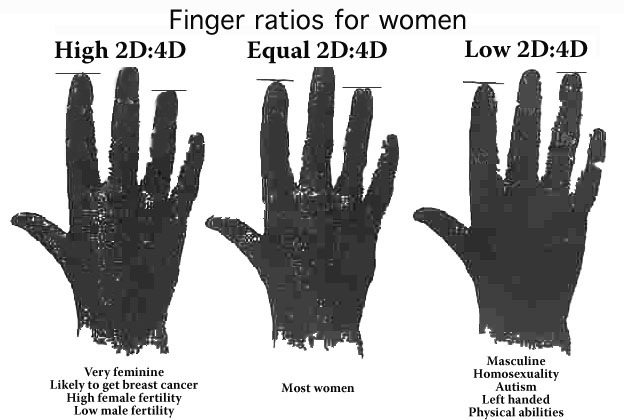 Ratios of 2nd digit (index finger) to 4th digit (ring finger). Manning hasn't yet checked the finger lengths of human dyslexics to see whether they also point to a testosterone link. But he has already checked out the left-handed idea, using a dexterity test. People are not always straightforwardly right or left- handed: many have been trained to use their right hand for writing, even if they are more skilled with the left. So Manning and his colleagues tested how quickly 285 children could move 10 pegs from one row of holes to another row five inches away, using one or the other hand. Children with low 2D:4D ratios (see illustration) are believed to have high exposure to testosterone in the womb and are more likely to be quicker with their left hands than the kids with higher ratios. This, he says, suggests that our degree of left-handedness (and more generally the way the brain divides up tasks between left and right hemispheres) may be influenced by hormone levels in the womb. Finger Length & Autism
"What we're hoping to look at is whether finger ratios can be used as a proxy for hormones," says Lutchmaya. Amniocentesis (sampling the amniotic fluic surrounding the unborn baby) is a risky procedure that only a few mothers choose to undergo, she says. But by measuring finger lengths instead, researchers can assess a random sample of children for possible early signs of impaired language and social skill development. Currently, they are checking the fingers of children for whom they have amniotic samples. Meanwhile, Manning and Baron-Cohen have looked at the finger ratios of 49 children with firm diagnoses of autism, 23 with a mild form of the disorder called Asperger's syndrome, and their families. The researchers found that autistic children tended to have very low 2D:4D ratios (see illustration). Interestingly, children with Asperger's syndrome had ratios that fell between those of autistics and unaffected children. "It fits exceptionally well with the theory," says Manning. Clearly genes play a role too in these conditions. But could fetal hormone levels explain other cognitive differences between the sexes? Janel Tortorice at Rutgers University in New Brunswick, New Jersey, thinks they may. She has measured finger ratios in 2D:4D ratio (see illustration) gay women and found that their hands were significantly different from those of heterosexual women-in fact, they tend to resemble those of heterosexual men. But she has also found differences in the way these women's brains work. "They have more masculine fingers and more masculine cognition," she says. On tests of spatial and verbal ability, lesbian volunteers perform more like men than heterosexual women, she says. If this can be confirmed by further studies, perhaps Manning's most recent suggestion is not as outrageous as it sounds. He claims that musical talent, too, is nurtured in the womb. Finger lengths foretell musical ability! Musicians with short ring fingers and lesbians with long index fingers needn't lose heart, however. Even if fingers win a place in the pantheon of diagnostic medicine, it's unlikely that prospective employers or partners will ever be able to predict our fortunes from our hands. Tortorice reminds us that males tend to be taller than females. "But," she says; "we don't use height to determine whether you're a man or a woman." How well does this apply to YOUR fingers? We'd like to know.
|
Monday, September 14, 2009
A finger on sexuality
Subscribe to:
Post Comments (Atom)












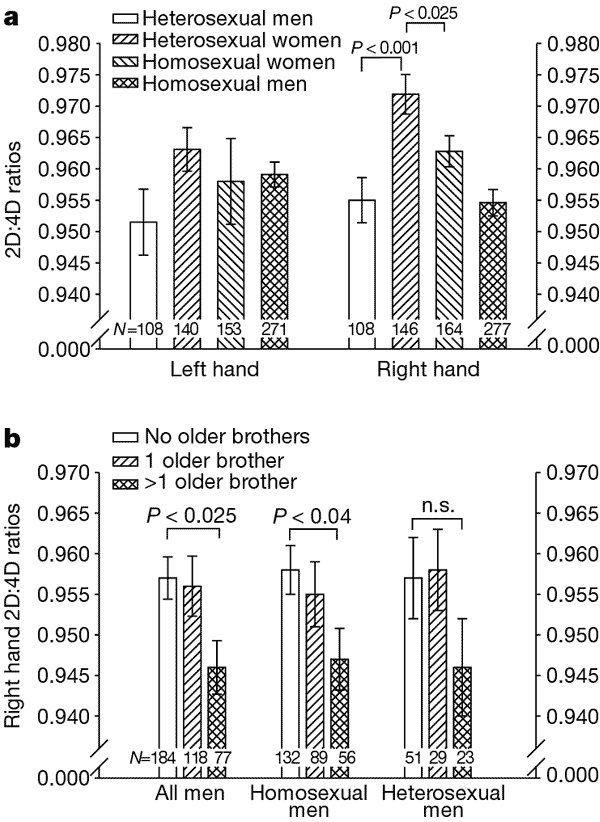 .
. 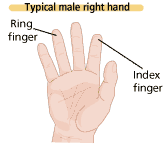
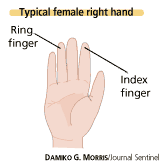

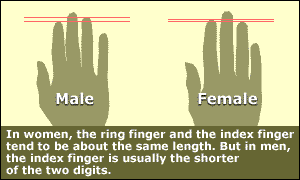 In a study to be published in the British Journal of Psychology, scientists compared the finger lengths of 75 children with their Standardised Assessment Test (SAT) scores. They found a clear link between a child's performance in numeracy and literacy tests and the relative lengths of their index (pointing) and ring fingers.
In a study to be published in the British Journal of Psychology, scientists compared the finger lengths of 75 children with their Standardised Assessment Test (SAT) scores. They found a clear link between a child's performance in numeracy and literacy tests and the relative lengths of their index (pointing) and ring fingers.  Oimitrios Tricopouos, an epidemiologist at Harvard University, proposed a decade ago that breast cancer may originate in the uterus of the mother (The Lancet, vol. 335, p 939). He suggested that high concentrations of estrogen may create a "fertile soil" for cancer to develop later in life. He also thought that variability in estrogen levels during pregnancy may help to explain why breast cancer rates are generally higher in women born to Caucasian mothers compared with those born to Oriental or younger mothers. Recently he and his colleague Karin Michels showed that high birth weight in girls-another sign of high prenatal estrogen levels-was associated with an increased risk of breast cancer.
Oimitrios Tricopouos, an epidemiologist at Harvard University, proposed a decade ago that breast cancer may originate in the uterus of the mother (The Lancet, vol. 335, p 939). He suggested that high concentrations of estrogen may create a "fertile soil" for cancer to develop later in life. He also thought that variability in estrogen levels during pregnancy may help to explain why breast cancer rates are generally higher in women born to Caucasian mothers compared with those born to Oriental or younger mothers. Recently he and his colleague Karin Michels showed that high birth weight in girls-another sign of high prenatal estrogen levels-was associated with an increased risk of breast cancer.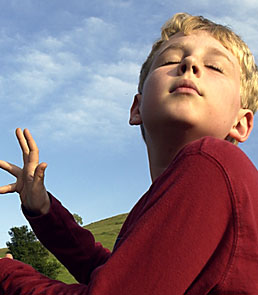 Manning has begun examining autism too. He teamed up with Simon Baron- Cohen and Svetlana Lutchmaya from the University of Cambridge, who have used samples of amniotic fluid to directly measure the levels of hormones that babies are exposed to in the womb. When the children reached their first birthday, the researchers measured their vocabularies and ability to make eye contact. Poor language skills and an unwillingness to make eye contact are early hallmarks of autism. They found that babies who'd been exposed to high levels of testosterone in the womb fared the worst.
Manning has begun examining autism too. He teamed up with Simon Baron- Cohen and Svetlana Lutchmaya from the University of Cambridge, who have used samples of amniotic fluid to directly measure the levels of hormones that babies are exposed to in the womb. When the children reached their first birthday, the researchers measured their vocabularies and ability to make eye contact. Poor language skills and an unwillingness to make eye contact are early hallmarks of autism. They found that babies who'd been exposed to high levels of testosterone in the womb fared the worst. Manning recruited 54 male musicians from a British symphony orchestra. He discovered that these men had significantly lower 2D:4D ratios than controls -- they had a very "masculine" ratio. Even more striking, when he compared the top-ranked "first" musicians with their lower-ranked colleagues -- a measure of their relative ability-the former had significantly lower 2D:4D ratios. Could testosterone really predispose the brain to be more tuned in to music? Manning thinks so.
Manning recruited 54 male musicians from a British symphony orchestra. He discovered that these men had significantly lower 2D:4D ratios than controls -- they had a very "masculine" ratio. Even more striking, when he compared the top-ranked "first" musicians with their lower-ranked colleagues -- a measure of their relative ability-the former had significantly lower 2D:4D ratios. Could testosterone really predispose the brain to be more tuned in to music? Manning thinks so.
No comments:
Post a Comment